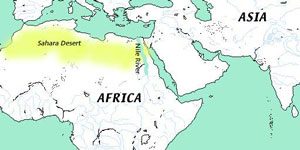
Egyptian geography: a map showing the Sahara desert and the Nile river
The Sahara Desert
Egypt has a very special environment, which has played a very big part in Egyptian history. Basically Egypt is really part of the Sahara Desert, which runs all across the top of Africa.
African environment
All our Egypt articles
Lots of Africa articles
But the Sahara is a really dry desert, and for the most part people do not live in the desert (though actually the Sahara was not as dry in antiquity as it is now). But even in antiquity it hardly ever rained in Egypt.
Why does it rain anywhere?
The Nile River ran through ancient Egypt
The reason people did live in Egypt, though, was that the Nile River runs through the middle of Egypt. The Nile is a big river. It starts in the rain forest south of Sudan, south of Egypt, near the A at the end of the word Africa on this map, and it flows north into the Mediterranean Sea. (If it seems funny to you that a river flows north, so that it looks like the water is going up on the map, you’re not alone. Lots of people find this hard to remember).
More about ancient Sudan
The Mediterranean Sea

Nile river with dry cliffs in the distance
Water from the Nile makes it possible to grow crops in Egypt, especially grains like wheat and barley, and beans like lentils or chickpeas.
History of wheat
What is barley?
Where do lentils come from?
People ate the wheat and barley, and they also used the straw to make shoes, hats, sleeping mats, baskets, and all kinds of other things.
History of straw
How did they make baskets?
More about Egyptian furniture
The Nile flooded every year
The way this worked in antiquity was that every year it would rain so much in the highlands of Ethiopia that the Nile river would flood. Most of Egypt flooded every year in the late summer and fall (earlier in the south and later in the north). The floods usually started in Aswan, in the south, about the middle of July. By the end of August, the flooding reached the northern Nile and the Mediterranean Sea. The flood waters were full of good black dirt (silt), carried down the river from central Africa by the flood. The flood waters also stranded lots of fish in shallow pools where they were easy to catch. By early October (in the south) and by late November (in the north), the flood waters would flow back into the river or evaporate, leaving the good new silt on the fields. This was a great natural fertilizer.
Different types of dirt
The history of fishing
The rest of the year, while the crops were growing, people got water from the Nile River to their fields in canals and irrigation ditches that they dug with wooden or bronze picks and shovels.
What is irrigation for?
As soon as you are too far from the Nile to get the water to the fields, it turns back into desert again (as you can see in the picture). In that desert, people made cemeteries for the dead. Right near the Nile was the land of the living, and further away, in the desert, was the land of the dead. So for the Egyptians, the land of the dead was close by: you could see it from your house.
Egyptian ideas about the afterlife
Egyptian houses
Did you find out what you wanted to know about Egyptian geography and the environment in ancient Egypt? Let us know in the comments!
Learn by doing: find out which rivers near you flow north, and which flow south
More about ancient Egyptian plants and animals
Bibliography and further reading about Egyptian geography and the environment:
Farming & Food (The Ancient Egyptians), by Jane Shuter (1998). Easy reading.
Everyday Life in Ancient Egypt, by Lionel Casson (revised edition 2001). Not as easy reading, but pretty entertaining, and Casson knows what he’s talking about.



WHy did they delete my comments????????
We delete useless or insulting comments.
who is yall
You can find out more about us here, Ralph: https://quatr.us/about
hi :)
not what i asked for on google.
Sorry! What were you trying to find out? I’ll be happy to answer your question.
Amazing
:)